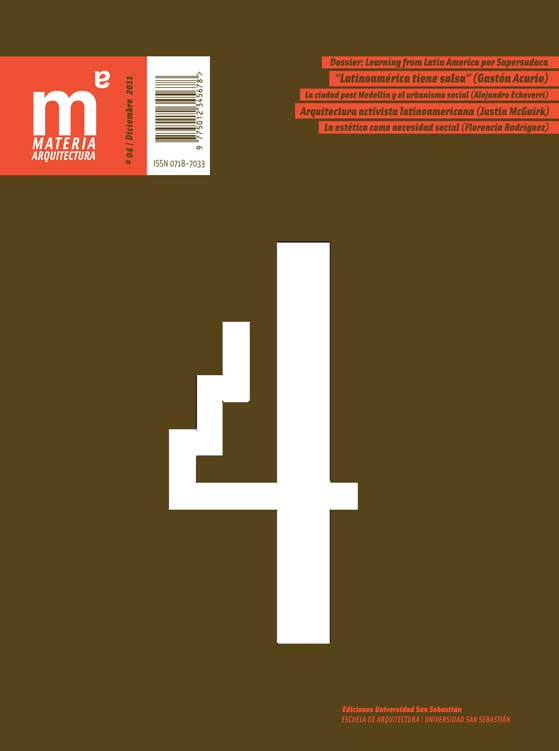The political dimension of architecture
Barra lateral del artículo
Palabras clave:
Contenido principal del artículo
Resumen
Justin McGuirk analyzes the causes for the world interest in Latin American town planning and details the reasons that took him to research a new type of architecture, “activist architecture”. He emphasizes the social dimension of professionals like Alejandro Aravena, Urban Think Tank, Jorge Mario Jáuregui and Teddy Cruz, and stops to give details of the historic referents that sustain such dimension: the work of John Turner on the Peruvian neighbourhoods, the PREVI housing experiment in Lima and the work of Vilanova Artigas, Sergio Ferro and Carlos Nelson in Brazil. McGuirk values the creation of urban infrastructures that are not governed by capitalist rules and emphasizes the work of the Tupac Amaru social Movement in the Northeast of Argentina. He stresses that Latin America found a political dignity that the developed world has lost. By means of examples such as the improvement of Paraisópolis and the introduction of alternative transport systems in cities like Caracas, Medellín and Río de Janeiro, he can assure that Latin America is teaching lessons to the rest of the world.
Detalles del artículo
Materia Arquitectura proporciona acceso inmediato y gratuito a todos los contenidos de esta edición electrónica, publicada simultáneamente con la edición impresa. Materia Arquitectura no cobra honorarios a los autores por ningún concepto.
Todos los contenidos de esta edición electrónica se distribuyen bajo licencia Creative Commons de “Atribución-Copartirigual 4.0 Internacional” (CC-BY-SA).
La licencia Creative Commons permite el acceso libre e inmediato al contenido y permite que cualquier usuario lea, descargue, copie, distribuya, imprima, busque o genere enlaces a los textos completos de los artículos, permitiendo también que estos puedan ser rastreados para indexarlos, pasarlos como datos a software o usarlos para cualquier otro propósito legal. Asimismo, la licencia otorga derechos de uso a quienes a su vez utilicen una licencia abierta (Creative Commons o equivalente).
Los derechos de los textos y las imágenes publicadas pertenecen a sus autores, quienes otorgan a Materia Arquitectura la licencia para su uso. La gestión de los permisos y la autorización de publicación de las imágenes (o de cualquier material) que contenga derechos de autor y sus consecuentes derechos de reproducción en esta publicación es de exclusiva responsabilidad de los autores de los artículos.
Toda vez que mencionen su origen, los autores son libres de distribuir sus artículos por otros medios. Cualquier reproducción total o parcial del material deberá citar su procedencia.
Descargas
Artículos más leídos del mismo autor/a
- Ana Rascovsky, Max Zolkwer, La estética como necesidad social , Materia Arquitectura: Núm. 04 (2011): Materia Arquitectura 04 (Diciembre/December 2011)
- Ana Rascovsky, La dimensión política de la arquitectura , Materia Arquitectura: Núm. 04 (2011): Materia Arquitectura 04 (Diciembre/December 2011)
- Stephane Damsin, Max Zolkwer, Ana Rascovsky, Manuel de Rivero, 1. La Bienal y la selva. 2. Conversando alrededor del mundo , Materia Arquitectura: Núm. 04 (2011): Materia Arquitectura 04 (Diciembre/December 2011)
- Ana Rascovsky, Max Zolkwer, Aesthetics as a social need , Materia Arquitectura: Núm. 04 (2011): Materia Arquitectura 04 (Diciembre/December 2011)
- Stephane Damsin, Max Zolkwer, Ana Rascovsky, Manuel de Rivero, 1. The Biennial and the jungle. 2. Talking around the world , Materia Arquitectura: Núm. 04 (2011): Materia Arquitectura 04 (Diciembre/December 2011)
